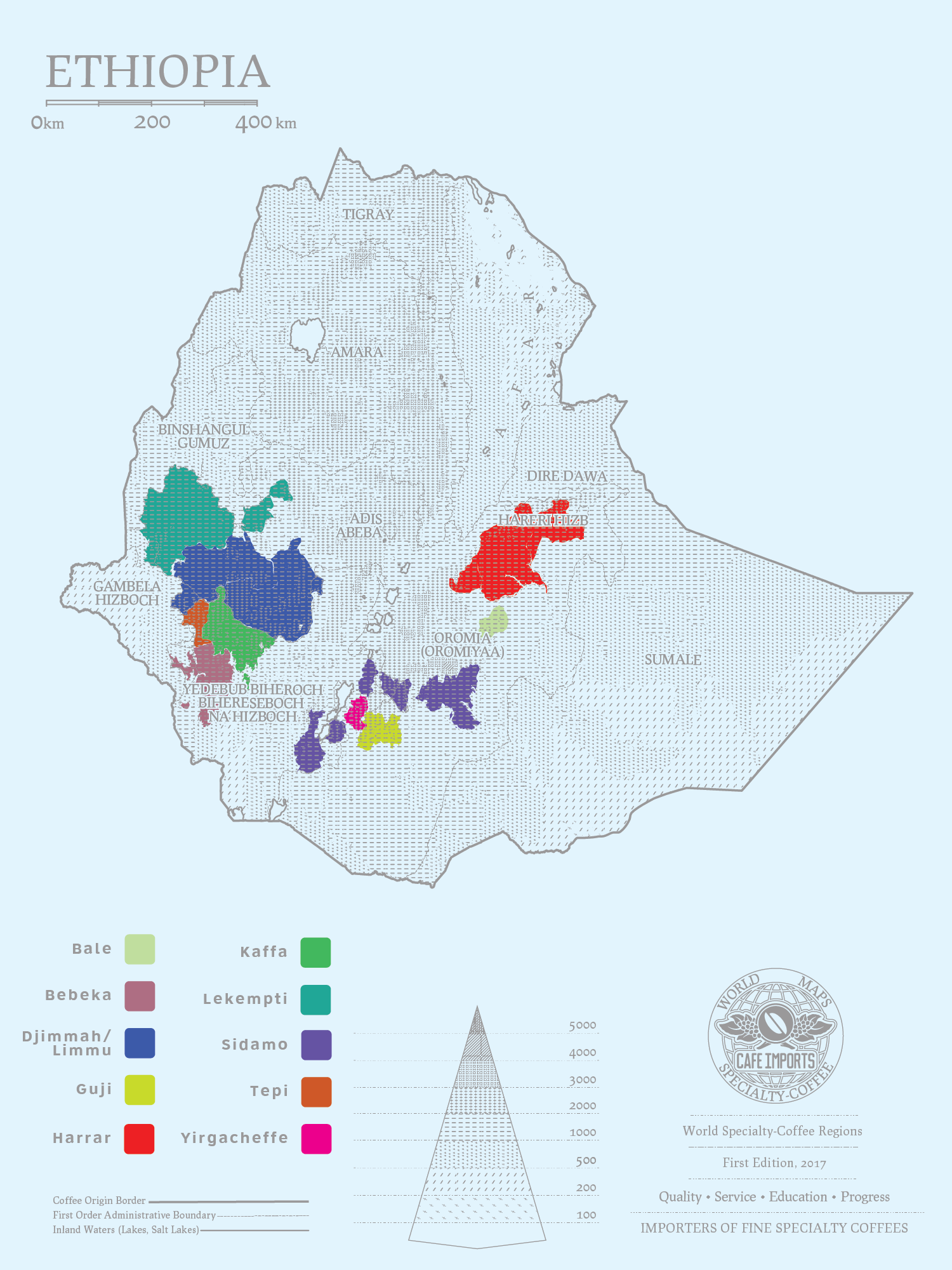The Development of Ethiopian Coffee the reasons for the Development of Ethiopian Coffee

Ethiopia, a landlocked country located in the Horn of Africa, is the most populous landlocked country in the world. Ethiopia is regarded as the birthplace of coffee-Arabica species (Arabica). It has rich native varieties and a wide range of genetic sequences, many of which can not be found in other countries. Coffee in Ethiopia is mostly grown by small farmers on their own small farms or in wild and semi-wild environments, and nearly 15 million people across the country are involved in growing and processing coffee beans. As the birthplace of Arabica coffee varieties, coffee consumption dates back to the 10th century, when the first African nomads to eat coffee fruits (coffee cherries / coffee cherries) mixed coffee beans, oil and spices into refreshing and refreshing foods. Coffee farmers in Ethiopia mostly grow and harvest coffee by hand, in conjunction with the "Coffee and Tea Development Department" set up by the local government to improve and manage all coffee beans.
In the coffee world, it is almost a recognized secret that the unique position of Ethiopian coffee comes in large part from the variety advantage of its place of origin, but if the origin of the world coffee (in this case only Arabica) is in Ethiopia, then Ethiopian coffee originated in the southwest, in the Kafa forest or near the border with South Sudan, in short, in the western half. It is not surprising that one of the priorities of the next generation will return to the western producing areas of Ethiopia.
If we trace the context of Ethiopia and the third wave of boutique coffee, we can actually find that before the third wave of boutique coffee, Ethiopia has a place in the coffee industry because of its strong varieties and geographical advantages. Sidamo, Yegashifi, Hara and Lim are all familiar names. After the beginning of the third wave, many government aid programs (such as USAID) and non-governmental organizations (i.e. NGO, such as the most important TechnoServe) worked together with raw bean merchants and cooked bean merchants. The most important area selected at the beginning was Yega Xuefei. The Red Cherry Project was also a product of this period, and this region participated in the project's regional cooperatives. (for example, Ediot Co-operative, Waka, Biloya Cooperative, Hofsa Cooperative … As a result, it became famous and blossomed into the establishment of the Yega Sheffield Coffee small Farmers Cooperative Union (YCFCU), which laid the foundation for the unshakable position of the Yega Sheffei producing area in the boutique coffee industry for decades to now. In the initial stage, the development of water washing treatment is still given priority to, because the introduction of foreign technology, especially the cause control of water washing treatment has the most immediate effect, in addition to the improvement of quality, it can also increase the income of small farmers on a large scale. Through the introduction of new machines, the education and training of picking ripe red cherries, the floating operation of unripe beans supplemented by water washing, and the variable control of the fermentation tank operation, we can get dried coffee. This can immediately show strong strength in Ethiopia, which has a unique advantage.
In the second stage, if you still remember, around 2006 and 2007, Bagersh was determined to revitalize the traditional tanning treatment method in Ethiopia. The first batch of Idido Misty Valley caused a hot sale, and the series of Aricha, Beloya and Ambassa, which cooperated with NINETYPLUS at the same time, were even more popular. At this point, Yega Xuefei's leading position has been fully established.
While the development of Yejasuefei has reached a phased task, people with lofty ideals (mainly TechnoServe), with successful experience, look at Ethiopia's vast fertile coffee shrine and finally cross the Great Rift Valley (Rift Valley) to the west. Techno Serve copied its past successful experience, and on the basis of Yega Xuefei, mainly made a lot of changes in the details of the treatment method. The first step is to improve the quality of washing in the past 10 years or so. In recent years, Nano Challa, Duromina, Yukuro, Hunda Oli and Biftu Gudina are famous cooperatives in Agaro, which is almost a place for European and American buyers to compete.

Important Notice :
前街咖啡 FrontStreet Coffee has moved to new addredd:
FrontStreet Coffee Address: 315,Donghua East Road,GuangZhou
Tel:020 38364473
- Prev

90 + Honey Kiss Coffee? what does Honey Kiss Coffee stand for? N2L12
Honey Kiss (Truth) Coffee originated from the nectar of Shakeso, and later Nikisse came from Walliga and Sidamo, but retained the name. Nikisse is characterized by a creamy and smooth taste, a strong berry sauce, and some batches even have mixed flavors of citrus and a variety of tropical fruits. There are flowers, jam, cream, milk chocolate, peaches, hundred
- Next

Introduction of Nicaraguan boutique coffee farm what are the flavor characteristics of Nicaraguan boutique coffee?
The Nicaraguan province of New Bosnia and Herzegovina is home to many smallholder coffee farms, and the harvested Ally Coffee is pleased to serve coffee from two very special places: Santa Teresa Demogutton and La Ilusion. Silvio Sanchez (Silvio Sanchez) came to grow coffee as a young entrepreneur. He and his mother both love coffee and are completing their agronomy degree.
Related
- Does Rose Summer choose Blue, Green or Red? Detailed explanation of Rose Summer Coffee plots and Classification in Panamanian Jade Manor
- What is the difference between the origin, producing area, processing plant, cooperative and manor of coffee beans?
- How fine does the espresso powder fit? how to grind the espresso?
- Sca coffee roasting degree color card coffee roasting degree 8 roasting color values what do you mean?
- The practice of lattes: how to make lattes at home
- Introduction to Indonesian Fine Coffee beans-- Java Coffee producing area of Indonesian Arabica Coffee
- How much will the flavor of light and medium roasted rose summer be expressed? What baking level is rose summer suitable for?
- Introduction to the characteristics of washing, sun-drying or wet-planing coffee commonly used in Mantenin, Indonesia
- Price characteristics of Arabica Coffee Bean Starbucks introduction to Manning Coffee Bean Taste producing area Variety Manor
- What is the authentic Yega flavor? What are the flavor characteristics of the really excellent Yejasuffi coffee beans?

